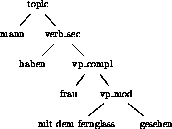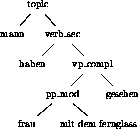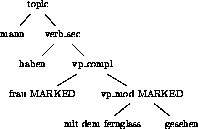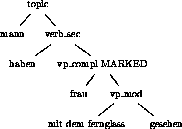


Next: Discussion Up: A monitoring strategy Previous: Redefining locality.
Simple attachment example.
In order to clarify the monitoring strategy we will now consider how an attachment ambiguity may be avoided. The following German sentence constitutes a simplified example of the sort of attachment ambiguity shown in (2).

Suppose indeed that the generator, as a first possibility, constructs this sentence in order to realize the (simplified) semantic representation:

Let us assume that the corresponding derivation tree is the tree in figure 3.

Figure 3: Derivation tree of German example
To find out whether this sentence is ambiguous the parser is called. The parser will find two results, indicating that the sentence is ambiguous. For the alternative reading the derivation tree shown in figure 4 is found.

Figure 4: Derivation tree of alternative reading

Figure 5: Marked tree of German example

Figure 6: Markers are pushed one level upward
The derivation tree of the result of generation is then compared with the trees assigned to the alternative readings (in this case only one), given rise to the marked derivation tree shown in figure 5.
The monitored generation will then try to find alternative possibilities at these marked nodes. However, no such alternatives exist. Therefore, the markers are pushed up one level, obtaining the derivation tree given in figure 6.
At this point the monitored generator again tries to find alternatives for the marked nodes, this time successfully yielding:

At this point we may stop. However, note that if we ask for further possibilities we will eventually obtain all possible results. For example, if the markers are pushed to the root node of the derivation tree we will also obtain

Gertjan van Noord
Thu Nov 24 18:08:35 MET 1994